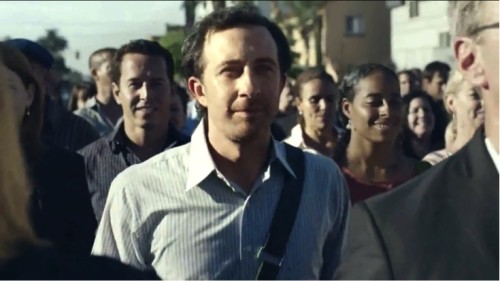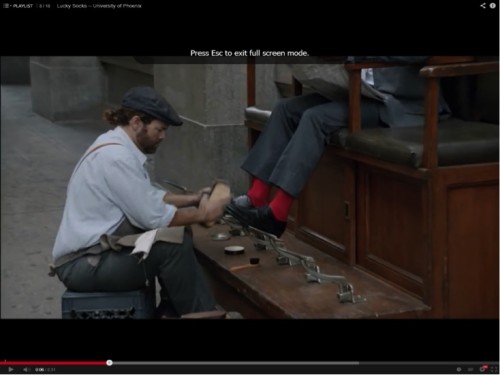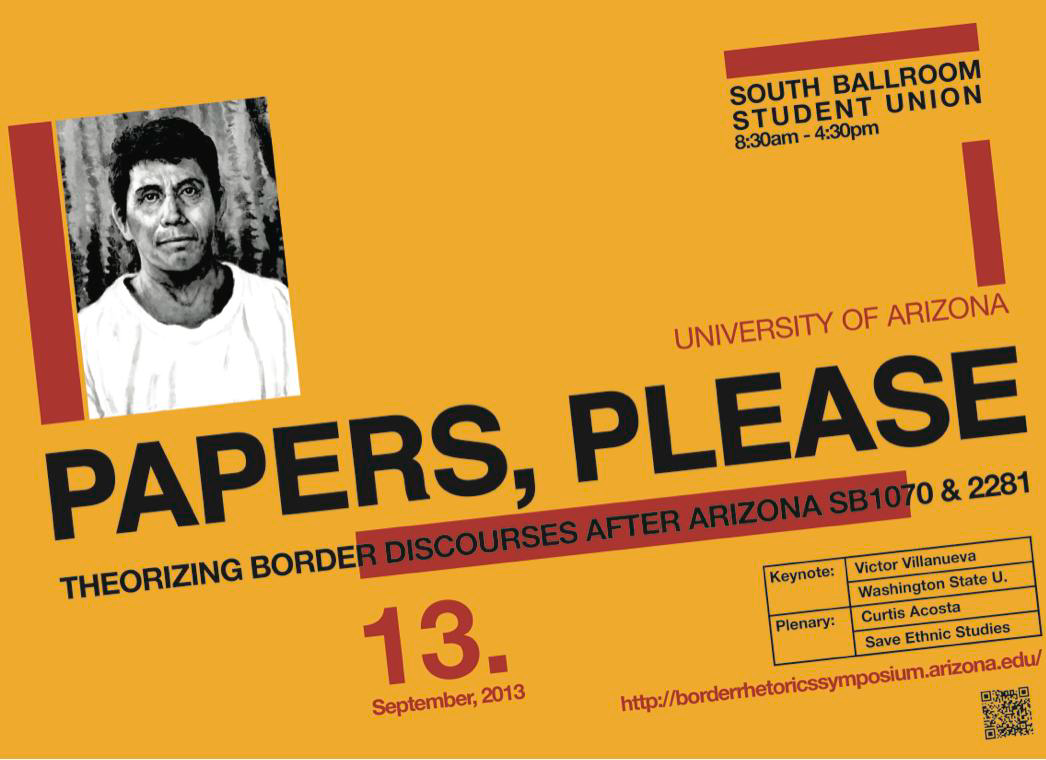Urgency, Anxiety, and Getting to Work: Paranoid Temporality and the Marketing of Higher Education
Founded in 1976, University of Phoenix has consistently promoted flexibility that meets students’ needs. Its “About Us” page credits the for-profit institution with “pioneer[ing] many of the conveniences that students now enjoy,” including night classes, continuous enrollment, and online education. And even if its recent history has been marred by news reports of slipping enrollments, campus closures, fraudulent recruiting, and accreditation woes,1 Phoenix continues to market a customer service ethos.
With its emphasis on workplace preparation, University of Phoenix’s “Let’s Get to Work” advertising campaign presents a Phoenix education as a fast-track to job entry or advancement. In keeping with today’s neoliberalism, the campaign links individual freedom with free market capitalism. Its images resonate with Bill Readings’s notion of “excellence,” wherein the contemporary university serves the interests of capital: skyscrapers become metonymic for “career advancement,” corporate logos promise “alumni networks,” coffee cups signal “busy schedules,” and commuters in business attire stand for “adult learners.” Integral to these ads, I argue, is the marketing of what Jaspir Puar has described as paranoid temporality, an understanding of time characterized by an urgency that suppresses creativity in favor of neoliberal values like “an easy privileging . . . .of innovation” (xx).
Reading “Let’s Get to Work” through Puar’s paranoid temporality enables rhetoricians to engage the concept of kairos in new ways. I suggest the campaign’s urgency constitutes a meta-kairotic discourse. Phoenix’s advertisements galvanize a fear of the now and challenge prospective students to respond immediately, framing the opportune moment as a last chance at economic security. The U.S. Department of Education’s student loan default rates suggest students who take this chance are often unable to pay for it; for-profit colleges and universities’ 22.7% three-year loan default rate ranks as the highest among all institutions. Degree completion is also uncertain. The Education Trust’s 2010 “Subprime Opportunity” cited University of Phoenix’s graduation rate as 9% among first-time, full-time baccalaureate degree students. The campaign’s treatment of temporality and its attendant meta-kairos therefore merit rhetoricians’ attention on multiple counts, not least of which involves questioning for-profit education’s promise of efficiency.
Conceptualizing Paranoid Temporality and Meta-Kairos
English studies has long been concerned with the impact of market logic on higher education. Contributors to Downing, Hurlbert, and Mathieu’s English, Inc. called for curricular reform over a decade ago, and recent scholarship has extended their critique by considering students’ present and future working lives (see Bousquet; Lu and Horner; Scott; and Welch). Scholars like Horner, Lindquist, and Mauk have paid particular interest to students’ time resources. Amy Robillard’s 2003 “It’s Time for Class” merits attention for its foresight along these lines. Describing students’ experience of time, Robillard argues that working class students are especially alienated by composition courses that use delayed gratification to prepare them for “bright futures as middle managers and CPAs” (75). She goes on to predict that this “fragmentation of time” will eventually affect all students as capitalism accelerates (76).
Robillard’s remarks resonate today. In response to students’ career anxieties, schools are complicating their ways of representing time in their promotional materials. Puar’s work on temporality offers a theoretical frame for understanding these representations. A study of queer identity in the context of Western nationalism and Islamophobia, Puar’s Terrorist Assemblages examines queer responses to 9/11, particularly the “new normativities” that enabled LGBTIQ communities to define themselves against terrorist others (xiii). As such, it speaks to the conformity that has come to dominate today’s political, economic, and educational landscapes. In much the same way as Kenneth Burke’s 1931 “Program” juxtaposed the “practical”—inclusive of “efficiency, prosperity, material acquisitions, [and] increased consumption”—with patriotism (111-12), Puar associates Western democracy with homogeneity. 9/11, says Puar, fostered a fear that galvanized “market interpellations of LGBTIQ subjects”; to secure mainstream membership, queer communities embraced American capitalism (xiv).2 College students are enacting a similar pattern. Driven by fears of unemployment, students view higher education as the route to career success and future security. Like the queer subjectivity Puar discusses, this capitulation to market values becomes a form of normativity that encourages competition, individualism, and expediency.
The condition that Puar, extending Eve Kosofsky Sedgwick’s work, describes as paranoid temporality characterizes the ways delayed gratification converges with a pervasive emphasis on the now. In Sedgwick’s critique of paranoia, she calls attention to the intellectual cynicism whose expectation of future calamity breeds conformity and forestalls action: “No time could be too early for one’s having-already-known, for its having-already-been-inevitable, that something bad would happen” (131). For Puar, paranoid temporality involves a pressing desire to guard against this uncertain future. It entails “an endlessly deferred or deflected gratification” that hopes to ensure “the quality of life for tomorrow” (27). Living according to paranoid temporality is nevertheless a fruitless pursuit, according to Puar, “for we are never safe enough, never healthy enough, never prepared enough” (xx).
Puar presents her alternative, anticipatory temporality, as distinct from Sedgwick’s anticipatory paranoia. Puar’s anticipatory temporality imagines a future steeped in possibility. It favors present-day risk-taking over stability and difference over conformity; it is unpredictable and open to multiple outcomes (xx). As such, anticipatory temporality allows for “critical creative politics,” including ways of being and relating that develop independent of the market (xx).
Puar’s distinction between paranoid and anticipatory temporality provides a basis for understanding the rhetorical strategies of “Let’s Get to Work,” particularly the campaign’s implications for kairos. Conventionally understood as “the right or opportune moment to do something” (Kinneavy 80), kairos has been complicated in recent scholarship. Michael Harker describes an ethically-minded kairos that cannot be reduced to “strictly temporal concerns” for “what is at stake, after all, is action in the world” (94). Applied to “Let’s Get to Work,” Harker’s formulation reveals Phoenix’s attempt to elicit action through a meta-kairos that both characterizes and fuels its audience’s paranoid temporality. The ads insert themselves into the cultural conversation about time at an opportune moment of job crisis and anxiety. Their messaging manipulates students’ fear of the future to present enrollment at University of Phoenix as a last chance at an anticipatory future.
As tempting as it is to vilify Phoenix’s predatory agency, it’s important to recognize that kairos, as articulated by Thomas Rickert in his work on ambient kairos, grows out of the complex interactions between rhetors and their unique situations: agency emerges “as something distributed, as something worldly” (121). University of Phoenix’s messaging arises from a complex neoliberal milieu that prioritizes workplace readiness and encompasses the changing locations of higher education: online, dispersed, decentralized. These factors drive—and thrive on—urgency and anxiety: the kairotic conditions, including the production, circulation, and reception of the ad campaign, spur a meta-kairotic ambience of paranoid temporality that leaves senders and receivers immersed in well-timed discourses about time.
Defining the Skills Gap
When the “Let’s Get to Work” campaign debuted in September 2012, it posed an opportunity for University of Phoenix to, as The Chronicle of Higher Education described, rehabilitate its brand. Phoenix released its two and a half-minute “Let’s Get to Work—The Backstory” along with its initial advertisements. “The Backstory” intersperses a discussion of the campaign rationale with footage from the first commercial’s shoot.3
Tellingly, “The Backstory” is steeped in verbal and visual rhetoric that conflates meta-kairos with paranoid temporality. Its opening on a building with boarded up windows and graffiti serves as a visual referent for the “skills gap” that Chief Marketing Officer Arra Yerganian articulates.

Despite Yerganian’s insistence that University of Phoenix is “unleashing, really, human potential,” “The Backstory” trades on students’ anxieties. The video acknowledges students’ time pressures, yet it simultaneously provokes them with its ticking clock, stark city streets, and headlines reading “Unemployment.”
“Fit[ting] school in,” the video implies, is essential to individual and national security. One can either be part of the problem—living in a graffiti-strewn building and unable to qualify for one of the 3.7 million unfilled jobs—or a University of Phoenix student with private sector connections. In this way, the videos resonate with Jennifer Wingard’s discussion of branding as “a central rhetorical technology of neoliberalism” (1). According to Wingard, branding redirects the anxieties associated with neoliberal capitalism onto “branded bodies,” such as immigrants and GLBT people, who fall outside the “appropriate and accepted citizenship categories” (1). This notion of branding as an “identification with and against particular groups” (9) speaks to “The Backstory’s” promise to connect students with “America’s greatest companies.” With its shots of American flags set to upbeat music, the video further insists individual accomplishment serves national interests. At the video’s conclusion, Yerganian asserts “The University of Phoenix knows that we’re in the right place at the right time.” And, he implies, so do the students who enroll—a theme that informs the campaign’s commercials and second “Backstory” video.4
Advertising the Tools for Success
Mostly narrated by Phylicia Rashad, who, as Blumenstyk points out, is known for portraying “a successful working mother” on The Cosby Show,5 the commercials emphasize forward momentum in the context of a new or better career. The ads stress Phoenix’s relationships with employers, and they feature actors whose race, age, and gender reflect target markets. A sense of urgency nevertheless characterizes the campaign: one must enroll at University of Phoenix immediately, the ads suggest, to ensure a better future for oneself, one’s family, and America.
The first commercial, “Let’s Get to Work America” laid the groundwork for subsequent ads. Set to “Amazing Grace,” the 60-second commercial depicts a solitary, unshaven, likely unemployed white man who joins a racially diverse crowd moving toward an unseen destination, his stricken expression giving way to a relaxed half-smile.

As in “The Backstory,” the present—the “right now”—is conflated with the future in an illustration of meta-kairos that evokes paranoid temporality: one must literally and figuratively join the throng of forward-marchers or be left behind with the window washers, hot dog vendors, and elderly women knitting in the periphery. In keeping with Wingard’s discussion of branding, this either/or choice underpins the campaign’s neoliberal messaging: join a group seeking competitive employment as the solution to an imperiled American dream or remain stuck in the past with unmarketable skills.
The other advertisements likewise characterize a University of Phoenix education in terms of upward or forward momentum. “Lucky Socks,” the ad that began the campaign’s second phase in January 2013, follows a crisply dressed black man as he makes his way to a job interview. The ad reiterates the promise and threat that drives the campaign. Throughout the video, University of Phoenix alumni are presented as an elite cohort. A figure emerging from a high-end sedan, a man getting his shoes shined, a woman sitting at a café in surgical scrubs and Crocs, and the interviewer himself are wearing their red University of Phoenix socks–they are the alumni who “can help connect you to a world of opportunity.” The unseen or barely glimpsed parking attendant, shoe-shiner, and barista presumably are not.

As the ad concludes, the job candidate is himself revealed to be wearing his lucky logo socks—63,000 pairs of which were purportedly sent to Phoenix alumni (Blumenstyk). Racial difference notwithstanding, he could be the unshaven prospective student from “Let’s Get to Work America,” transformed by his Phoenix education into a confident professional with a lucrative future.
Nearly two years into the campaign, the job crisis of “Let’s Get to Work America” and the job search of “Lucky Socks” have given way to the job accomplishment depicted in “Career GPS,” “Rocket,” and other recent videos. Although they continue to use time to motivate enrollment, the most recent commercials promote an optimism that masks their reliance on paranoid temporality. “Career GPS,” for example, insists “you can’t afford wrong turns on the road to your future” while tracking a woman’s upward progress through the levels of an office building.

The ad’s digitized graphics draw us into the scene: the protagonist becomes our avatar, and we vicariously experience her success. That she eventually arrives at the head of a conference table, however, implies a level of individual agency that GPS directions, geared toward efficiency, discourage. After all, who has time for risky creative choices when you must arrive at your destination as quickly as possible? “Rocket” sends a similar message.

On the surface, “Rocket”’s portrait of a girl who aspires to the iconic American career of astronaut appears to invoke the anticipatory future Puar envisions, particularly for women and minorities. Rashad’s narration reverts to paranoid messaging, however, when it encourages students to “imagine” a direct path to their chosen careers, the culminating rocket launch contrasting Phoenix’s clearly-defined career goals to the inefficiency of “today’s educational system.”
Resisting the Rhetoric of Paranoid Temporality
Encumbered by neoliberal anxieties about how to use, manage, and maximize time, today’s students are justifiably concerned about how their present choices will impact their futures. “Let’s Get to Work” appears to address this concern by explicitly acknowledging it. As indicated, however, this self-reflexivity has a troubling undercurrent. The commercials’ awareness of paranoid temporality not only exacerbates it, but also directs it toward populations who are especially vulnerable to promises of career success: unemployed or underemployed adults, parents, women, and minorities.
Phoenix’s campaign is not an isolated example. Highway billboards advertise “Careers in Two Years or Less!” College websites ask, “Why are you waiting?” A commercial from my own institution features returning adult students who repeat the phrase, “It was time.” Advertisements like these offer a productive site for probing higher education’s relationship to the marketplace, particularly education’s increasing association with an ambience of fear. In addition to revealing how colleges and universities participate in normalizing paranoid temporality, these promotional materials rely upon a meta-kairotic discourse in which references to time become a means of motivating action. Invoking time—and, as in the case of Phoenix’s campaign, framing the failure to act quickly as an individual mistake that threatens the larger nation—becomes a strategy for gut-level persuasion. Meta-kairos and paranoid temporality merge, with both serving as the advertisements’ subjects and their strategies. Such references to time become a rhetorical shortcut that fosters quick decision-making and fuels the conformity and homogeneity represented by the first commercial’s marching crowd.
Rhetoricians seeking to cultivate the anticipatory temporality Puar envisions have a vested interest in calling attention to branding discourse that insists we act now. Teaching students to recognize the ways paranoid temporality and meta-kairos feed off of one another in advertisements like “Let’s Get to Work” is a step in this direction. Such advertisements offer productive, transferable case studies: they invoke a context that is immediately meaningful for students, and their consequences, especially financially, merit the reflection that is itself characteristic of anticipatory temporality. These investigations promote awareness of neoliberal constructions of time in advertising and beyond. More significantly, this critical temporal inquiry supports anticipatory thinking in which “the frenetic speeds of crisis and urgency” give way to a “slowing of time” (Puar xxi) that values informed economic decisions and validates the process of making them.
Endnotes
- University of Phoenix was recently placed on notice by the Higher Learning Commission of the North Central Association of Colleges and Schools (HLC). This action revised a February 2013 recommendation for a two-year probation based on University of Phoenix’s “insufficient autonomy relative to its parent corporation and sole shareholder, Apollo Group, Inc.” (qtd. in Fain). return
- For a helpful overview of Terrorist Assemblages, see Puar’s 2012 lecture at the American University of Beirut. return
- Because the advertisements and associated videos rotate through University of Phoenix’s website and YouTube channel, with older ads cycling out as newer ones debut, I’ll include screen shots rather than hyperlinked video clips. Readers are encouraged to do keyword searches for the complete videos. return
- As of this writing, I’ve counted approximately 17 “Let’s Get to Work” commercials, some with multiple cuts. Determining an exact number is challenging, however, in light of the rotation discussed in Note 3. return
- Rashad also served as University of Phoenix’s 2013 Commencement Speaker. return
Works Cited
- Blumenstyk, Goldie. “University of Phoenix Reboots Advertising and Rebrands in the Process.” The Chronicle of Higher Education. The Chronicle of Higher Education, 6 Feb. 2013. Web. 16 July 2013. <http://chronicle.com/blogs/bottomline/u-of-phoenix-reboots-advertising-and-rebrands-in-the-process/>.
- Bousquet, Marc. How the University Works: Higher Education and the Low-Wage Nation. New York: New York UP, 2008. Print.
- Burke, Kenneth. “Program.” Counter-Statement. 1931. Berkeley: U of California P, 1968. 107-22. Print.
- Downing, David B., Claude Mark Hurlbert, and Paula Mathieu, eds. Beyond English Inc.: Curricular Reform in a Global Economy. Portsmouth, NH: Heinemann/Boynton-Cook, 2002. Print.
- The Education Trust. “Subprime Opportunity: The Unfulfilled Promise of For-Profit Colleges and Universities.” The Education Trust. The Education Trust, Nov. 2010. Web. 22 May 2014. <http://www.edtrust.org/sites/edtrust.org/files/publications/files/Subprime_report_1.pdf>.
- Fain, Paul. “Possible Probation for Phoenix.” Inside Higher Ed. Inside Higher Ed, 26 Feb. 2013. Web. 20 June 2013. <http://www.insidehighered.com/news/2013/02/26/university-phoenix-faces-possible-probation-accreditor>.
- Harker, Michael. “The Ethics of Argument: Rereading Kairos and Making Sense in a Timely Fashion.” CCC 59.1 (2007): 77-97. Print.
- Harlin, Kevin. “University of Phoenix Enrollment Slides, But EPS Beat.” Investor’s.com. Investor’s Business Daily, 25 Mar. 2013. Web. 20 June 2013. <http://news.investors.com/business/032513-649210-apollo-group-university-of-phoenix-earnings.htm>.
- Higher Learning Commission. “Public Disclosure Notice on University of Phoenix.” Higher Learning Commission. The Higher Learning Commission, 27 June 2013. Web. 16 July 2013. <http://www.ncahlc.org/download/_PublicDisclosureNotices/PDN_1949.pdf>.
- Horner, Bruce. Terms of Work for Composition: A Materialist Critique. Albany: SUNY, 2000. Print.
- Kinneavy, James L. “Kairos: A Neglected Concept in Classical Rhetoric.” Rhetoric and Praxis: The Contribution of Classical Rhetoric to Practical Reasoning. Ed. Jean Dietz Moss. Washington, DC: Catholic U of America P, 1983. 79-105. Print.
- Lewin, Tamar. “For-Profit College Group Sued as U.S. Lays Out Wide Fraud.” The New York Times. The New York Times Company, 8 Aug. 2011. Web. 20 June 2013. <http://www.nytimes.com/2011/08/09/education/09forprofit.html>.
- —. “University of Phoenix to Shutter 115 Locations.” The New York Times. The New York Times Company, 17 Oct. 2012. Web. 20 June 2013. <http://www.nytimes.com/2012/10/18/education/university-of-phoenix-to-close-115-locations.html?_r=1&>.
- Lindquist, Julie. “What’s the Trouble with Knowing Students? Only Time Will Tell.” Pedagogy: Critical Approaches to Teaching Literature, Language, Composition, and Culture 10.1 (2010): 175-82. Print.
- Lu, Min-Zhan, and Bruce Horner. “Composing in a Global-Local Context: Careers, Mobility, Skills.” College English 72.2 (2009): 113-33. Print.
- Mauk, Johnathon. “Location, Location, Location: The ‘Real’ (E)states of Being, Writing, and Thinking in Composition.” College English 65.4 (2003): 368-88. Print.
- Puar, Jaspir K. “Homonationalism Gone Viral: Discipline, Control, and the Affective Politics of Sensation.” YouTube. YouTube, 3 May 2012. Web. 25 June 2013. <http://youtu.be/6a0Dkn3SnWM>.
- —. Terrorist Assemblages: Homonationalism in Queer Times. Durham: Duke UP, 2007. Print.
- Readings, Bill. The University in Ruins. Cambridge, MA: Harvard UP, 1996. Print.
- Rickert, Thomas. Ambient Rhetoric: The Attunements of Rhetorical Being. Pittsburgh: U of Pittsburgh P, 2013. Print.
- Robillard, Amy E. “It’s Time for Class: Toward a More Complex Pedagogy of Narrative.” College English 66.1 (2003): 74-92. Print.
- Sedgwick, Eve Kosofsky. Touching Feeling: Affect, Pedagogy, Performativity. Durham, NC: Duke UP, 2003. Print.
- Scott, Tony. Dangerous Writing: Understanding the Political Economy of Composition. Logan: Utah State UP, 2009. Print.
- United States Government. “First Official Three-Year Student Loan Default Rates Published.” ED.gov. U.S. Department of Education, 28 Sept. 2012. Web. 22 May 2014. <https://www.ed.gov/news/press-releases/first-official-three-year-student-loan-default-rates-published-0>.
- University of Phoenix. “About Us.” University of Phoenix. University of Phoenix, 2013. Web. 18 June 2013. <http://www.phoenix.edu/about_us/about_university_of_phoenix.html>.
- —. “Career GPS.” YouTube. YouTube, 25 July 2013. Web. 30 July 2013. <http://www.youtube.com/watch?v=HbBsHecjNf0>.
- —. “Let’s Get to Work America.” YouTube. YouTube, 23 Sept. 2012. Web. 17 July 2013. <http://www.youtube.com/watch?v=BclAhAU40ss>.
- —. “Let’s Get to Work—The Backstory.” YouTube. YouTube, 24 Sept. 2012. Web. 17 July 2013. <http://www.youtube.com/watch?v=Wq_laXYAnUU>.
- —. “Let’s Get to Work—The Backstory 2.” YouTube. YouTube, 14 Jan. 2013. Web. 17 July 2013. <http://www.youtube.com/watch?v=XCeAn8AhPao>.
- —. “Lucky Socks.” YouTube. YouTube, 14 Jan. 2013. Web. 17 July 2013. <http://www.youtube.com/watch?v=-EVwCPMO0Q0>.
- —. “Rocket.” YouTube. YouTube, 9 Jan. 2014. Web. 19 June 2014. <http://www.youtube.com/watch?v=FYa8mRZOB2c>.
- Welch, Nancy. Living Room: Teaching Public Writing in a Privatized World. Portsmouth, NH: Heinemann/Boynton-Cook, 2008. Print.
- Wingard, Jennifer. Branded Bodies, Rhetoric, and the Neoliberal Nation-State. Plymouth, UK: Lexington, 2013. Print.




 Jeanne Marie Rose is Associate Professor of English at Penn State University, Berks. She teaches courses in first-year composition, professional writing, and American Literature, and her research focuses on writing pedagogy. Her work has appeared in Computers and Composition, Composition Forum, Pedagogy, and other journals.
Jeanne Marie Rose is Associate Professor of English at Penn State University, Berks. She teaches courses in first-year composition, professional writing, and American Literature, and her research focuses on writing pedagogy. Her work has appeared in Computers and Composition, Composition Forum, Pedagogy, and other journals.